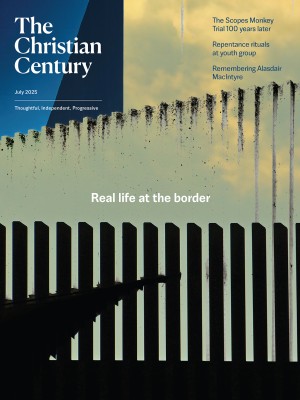July 13, Ordinary 15C (Luke 10:25–37)
Mr. Rogers turns the self-protecting question, “Who is my neighbor?” into a self-expanding invitation.
Jesus understands the power of imagination and the way that a simple image can lead us into new worlds of understanding and action. His parables put abstract faith into tangible reels that linger in our minds. Rather than crafting a complex theological response to the question, “Who is my neighbor?” Jesus tells a timeless story, with characters that are believable even centuries later. If we veer too far from the basic impact of the parable with heavy doctrinal discussions, we risk losing its power as a real example we can emulate.
In Texts Under Negotiation, Walter Brueggemann posits that people do not change much because of doctrinal argument or sheer cognitive or moral appeal. “People in fact change by the offer of new models, images, and pictures of how the pieces of life fit together,” he says. “Transformation is the slow, steady process of inviting each other into a counterstory about God, world, neighbor, and self. This slow, steady process has as counterpoint the subversive process of unlearning and disengaging from a story we find no longer to be credible or adequate.” The parable of the good Samaritan helps us imagine God’s counterstory with relatable people and actions. When we can translate those kinds of actions into our own lives, the Good News comes to life—and our community becomes richer because of its diversity and shared care.
Read our latest issue or browse back issues.
Who is my neighbor? This is a relevant question for the contemporary church. If Christians could answer it with one definitive response, then the church could finally hold itself accountable and act in solidarity with those who are hurting and need care. But centuries after this question was posed to Jesus, we still muddle his response about loving God and neighbor. We continue to stir up excuses for our hesitation and limitations in offering mercy or compassion. Jesus doesn’t identify why the priest and the Levite don’t offer care, so we fill in with our own possible excuses: a lack of expertise in triage care, a concern that giving time to one need would steal time from another. Or maybe it’s sheer callousness or simple fear. The excuses are insignificant as Jesus turns the focus on the positive action that demonstrates a neighborly love.
The law expert who asks, “Who is my neighbor?” reveals a self-focused motive. His primary concern is his own salvation: What must he do to inherit eternal life? He wants affirmation that his knowledge is going to give him an eternal reward. He wants an easy template to place over his life to prove that he is following the law of God. That temptation lingers in our own propensity to look for binary answers to faith’s hardest questions.
For decades Fred Rogers began each episode of his children’s program with the original song “Won’t You Be My Neighbor?” The words hint at the show’s themes of compassion and kindness: “I have always wanted to have a neighbor just like you. . . . / Would you be mine? Could you be mine? / Won’t you be my neighbor?”
Mr. Rogers’s lyrics turn the self-protecting question of “Who is my neighbor?” into a self-expanding invitation. It’s a shift in perspective, expecting that our lives and our community will be even more beautiful as they become filled with new neighbors. It was a countercultural idea then and continues to exist in contrast with a secular narrative that describes outsiders as a dangerous intrusion into our comfortable neighborhoods. Jesus invites us to embrace this sort of boundaryless approach, full of anticipation rather than dread. When there are tangible ways to serve others and to share mercy and kindness, taking them up is not our obligation but our delight. When we recall how Jesus related to others, it confirms the wisdom that there are two kinds of people: those we love and those we haven’t yet met.
At a vacation hotel I was amused when the locker room attached to the swanky golf clubhouse had an unusual designation: the “transformation room.” But I can’t argue with its premise. Indeed, most people exit the space with some degree of physical change. I wonder if we can approach this familiar parable with creativity and a new expectation that it will not be merely a cognitive exercise but a truly transformational engagement, one that helps us to be more like Jesus. Can we imagine how our lives will be different—and the Good News more tangibly expressed—if we stop trying to identify the boundaries of our neighborhood and focus instead on how we can bravely ask others around us who are in need to be our neighbors?






